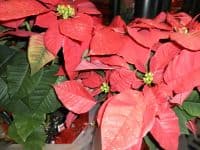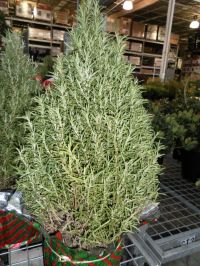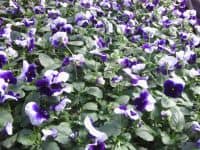
Holiday Plants
Decorative plants such as poinsettias, cyclamen, holiday cactuses, rosemary and living Christmas trees can play an important part in decorating our homes for the holidays.
After purchasing a holiday plant, protect it while bringing it home. Sudden exposure to low temperatures and wind will damage the plant. Poinsettias are particularly fragile. It’s best to have them sleeved before you take them out of the store. When you get them home, the plants should be located for attractive display, but a spot where they will receive some natural light will give best results.
Holiday plants often are sold in pots wrapped in decorative coverings. Punch holes in the covering where the drainage holes of the pot are located to allow the soil to drain properly when you water. Also, make sure the furniture or floor you set your plant on is protected by a plastic saucer. Another option is to remove the pot from the decorative covering, take the plant to the sink, water it and allow it to drain there before you return it back to the location where you are displaying it and slip it back into the decorative pot cover.
Plants should be checked for moisture daily by feeling the soil with your finger. Water thoroughly when the soil begins to feel dry. Never let a holiday plant wilt.
Allowing a plant to dry out, low light, low humidity, drafts and placing them near sources of heat all can shorten the attractive life of your holiday plant. You can make sure that your holiday plants will provide a beautiful display throughout the season with a little tender love and care.

Rosemary for Holiday Decoration
Rosemarinus officinalis or Dwarf Rosemary is a hardy, aromatic, culinary perennial or evergreen shrub. Rosemary is native of the Mediterranean which
performs best in full sun in well-drained, porous, dry and sandy soil. This plant requires little fertilization and is somewhat short-lived. The needle-like leaves make rosemary the perfect plant to use as miniature Christmas trees, container plantings and topiary. Keep plants somewhat dry and allow them to dry in between watering. Rosemary is used for landscaping and reclamation, as an herb, for medicinal, cosmetic purposes and in kitchen plantings
Winter Garden Tips
Begin to plant tulip and hyacinth bulbs that have been refrigerated for at least 6 weeks at the end of this month and early January.
Roses can be transplanted through late February.

Continue to cut back fall-blooming perennials after they have bloomed.
Protect tender perennials from cold with several inches of mulch.
Cut back freeze damaged plants below damaged area after the last frosts of the season. Protect potted tropical & tender plants from freezes by bringing them indoors in a garage or greenhouse. In ground plants can be transplanted to pots or tented by using plastic & wooden steaks. Do not let plastic come into contact with the plant leaves to avoid frost. Open the tent to air the next morning after the freeze has past because the sun can heat up the tent & burn plants. Don’t forget to return plants outdoors after the threat of frost has past.

Pansy
Pansy or Viola x wittrockiana-grown as an annual is a short-lived perennial. Pansy should be planted from November to March. It is a popular bedding plant in our area. It works well in containers as an under planting for other plants such as roses and over bulb plantings. Pansies provide winter and spring color. Flowers are large, round, velvet-like with multi-color blends of blue, white, yellow, red and orange. Some blooms are fragrant. They bloom best in full sunlight in well drained soil. Add peat moss or pine bark plus sand to the planting area. Mulch plants with one inch of pine bark after planting. Fertilize 1 to 2 times a month with a soluble fertilizer. Pansies can withstand very cold temperatures and begin to decline in hot weather. Pinch or deadhead blooms to extend the flowering season. Caterpillars can be controlled with Bt and slugs and snails with baits.

Cool Veggies
Vegetables to plant in December include beets, Brussels sprouts (transplants), cabbage, collards, garlic (toes), kale, kohlrabi, leeks (transplants), lettuce, mustard, onions (sets or transplants), radishes, rutabaga, shallots (sets), spinach, Swiss chard, and turnips.
submitted by Karen Blackburn
